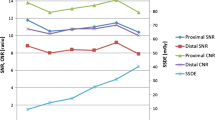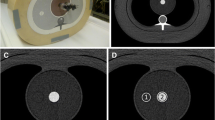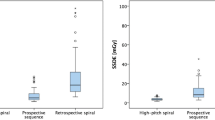Abstract
To evaluate the effective radiation dose and image quality resulting from use of 100 vs. 120 kV among patients referred for cardiac dual source CT exam (DSCT). Prospective data was collected on 294 consecutive patients referred for DSCT. For each scan, a physician specializing in cardiac CT chose all parameters including tube current and voltage, axial versus helical acquisition, and use of tube current modulation. Lower tube voltage was selected for thinner patients or when lower radiation was desired for younger patients, particularly females. For each study, image quality (IQ) was rated on a subjective IQ score and contrast (CNR) and signal-to-noise (SNR) ratios were calculated. Tube voltage of 100 kV was used for 77 (26%) exams while 120 kV was used for 217 (74%) exams. Use of 100 kV was more common in thinner patients (weight 166lbs vs. 199lbs, P < .001). The effective radiation dose for the 100 and 120 kV scans was 8.5 and 15.4 mSv respectively. Among scans utilizing 100 and 120 kV, there was no difference in exam indication, use of beta blockers, heart rate, scan length and use of radiation saving techniques such as prospective ECG triggering and tube current modulation. The IQ score was significantly higher for 100 kV scans. While 100 kV scans were found to have higher image noise then those utilizing 120 kV, the contrast-to-noise and signal-to-noise were significantly higher (SNR: 9.4 vs. 8.3, P = .02; CNR: 6.9 vs. 6.0, P = .02). In selected non-obese patients, use of low kV results in a substantial reduction of radiation dose and may result in improved image quality. These results suggest that low kV should be used more frequently in non-obese patients.


Similar content being viewed by others
References
Bluemke DA, Achenbach S, Budoff M, Gerber TC, Gersh B, Hillis LD, Hundley WG, Manning WJ, Printz BF, Stuber M, Woodard PK (2008) Noninvasive coronary artery imaging. Magnetic resonance angiography and multidetector computed tomography angiography. A scientific statement from the American heart association committee on cardiovascular imaging and intervention of the council on cardiovascular radiology and intervention, and the councils on clinical cardiology and cardiovascular disease in the young. Circulation
Einstein AJ, Henzlova MJ, Rajagopalan S (2007) Estimating risk of cancer associated with radiation exposure from 64-slice computed tomography coronary angiography. JAMA 298(3):317–323
Hausleiter J, Meyer T, Hadamitzky M, Huber E, Zankl M, Martinoff S, Kastrati A, Schomig A (2006) Radiation dose estimates from cardiac multislice computed tomography in daily practice: impact of different scanning protocols on effective dose estimates. Circulation 113(10):1305–1310
Feuchtner GM, Jodocy D, Klauser A, Haberfellner B, Aglan I, Spoeck A, Hiehs S, Soegner P, Jaschke W (2009) Radiation dose reduction by using 100-kv tube voltage in cardiac 64-slice computed tomography: a comparative study. Eur J Radiol. doi:S0720-048X(09)00417-3[pii]10.1016/j.ejrad.2009.07.012
Heyer CM, Mohr PS, Lemburg SP, Peters SA, Nicolas V (2007) Image quality and radiation exposure at pulmonary ct angiography with 100- or 120-kvp protocol: prospective randomized study. Radiology 245(2):577–583
Leschka S, Stolzmann P, Schmid FT, Scheffel H, Stinn B, Marincek B, Alkadhi H, Wildermuth S (2008) Low kilovoltage cardiac dual-source ct: attenuation, noise, and radiation dose. Eur Radiol 18(9):1809–1817
Paul JF, Abada HT (2007) Strategies for reduction of radiation dose in cardiac multislice ct. Eur Radiol 17(8):2028–2037
Einstein AJ (2009) Radiation protection of patients undergoing cardiac computed tomographic angiography. JAMA 301(5):545–547
Hausleiter J, Meyer T, Hermann F, Hadamitzky M, Krebs M, Gerber TC, McCollough C, Martinoff S, Kastrati A, Schomig A, Achenbach S (2009) Estimated radiation dose associated with cardiac ct angiography. JAMA 301(5):500–507
Alkadhi H, Stolzmann P, Scheffel H, Desbiolles L, Baumuller S, Plass A, Genoni M, Marincek B, Leschka S (2008) Radiation dose of cardiac dual-source ct: the effect of tailoring the protocol to patient-specific parameters. Eur J Radiol 68(3):385–391. doi:S0720-048X(08)00495-6[pii]10.1016/j.ejrad.2008.08.015
Acknowledgments
Drs. Blankstein and Rogers received support from NIH grant 1T32 HL076136-02.
Conflict of interest
None.
Author information
Authors and Affiliations
Corresponding author
Rights and permissions
About this article
Cite this article
Blankstein, R., Bolen, M.A., Pale, R. et al. Use of 100 kV versus 120 kV in cardiac dual source computed tomography: effect on radiation dose and image quality. Int J Cardiovasc Imaging 27, 579–586 (2011). https://doi.org/10.1007/s10554-010-9683-3
Received:
Accepted:
Published:
Issue Date:
DOI: https://doi.org/10.1007/s10554-010-9683-3




